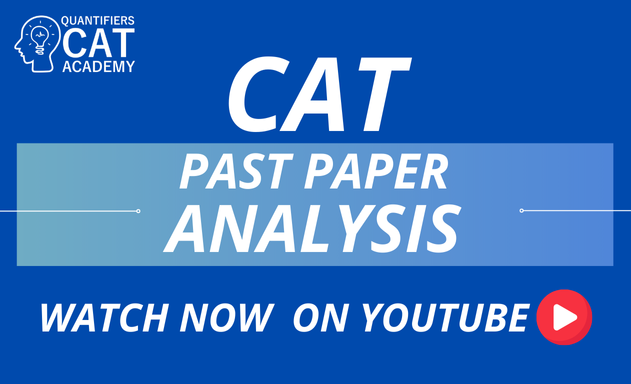Welcome to the CAT 100 Day Challenge
100 days. 100 questions. One shot at your IIM dream.
The CAT exam isn’t cracked in one night—it’s conquered through daily consistency. That’s why we created the CAT 100 Day Challenge: a free prep journey where you solve one high-quality CAT-level question every day, complete with solutions, shortcuts, and expert tips. In less than 10 minutes a day, you’ll build unstoppable momentum, sharpen your skills, and stay exam-ready without overwhelm. Whether you’re starting late or fighting procrastination, this challenge is your daily push to stay disciplined, focused, and ahead of the competition.
Start today. One question → one habit → one step closer to your IIM seat.
CAT in 100 Days
Day 1 of 100: Mini QA Challenge
The cost of labor in manufacturing a product is 16.66% of the total cost. Due to improvements in automation, the cost of labor decreased to 12.5% of total cost, all other cost remaining the same. Find the percentage decrease in the cost of labor.
Correct Answer
28.57
Day 2 of 100: Data Interpretation Quickie
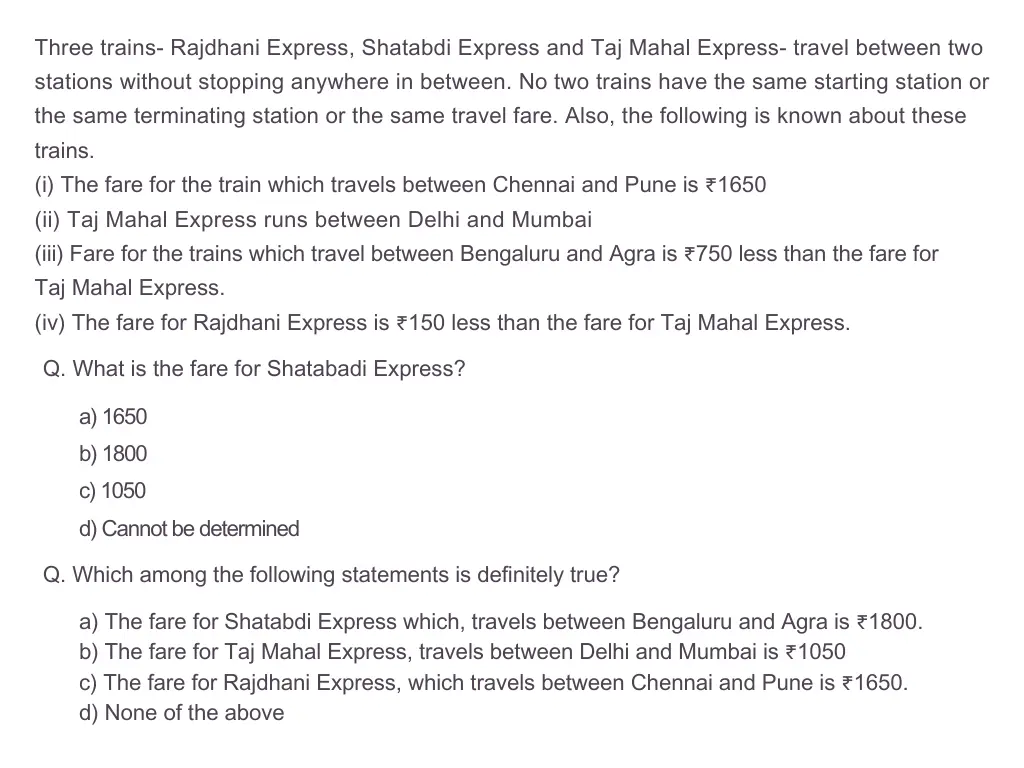
Correct Answer 1
Option C
Correct Answer 2
Option C
Chennai - Pune => 1650
TM Exp => Delhi - Mumbai => Rs X
Beng - Agra => X - 750
Raj Exp => X - 150
Shatabdi Exp is clearly the one running b/w Beng - Agra (X - 750)
X - 150 = 1650
X = 1800
Fare of Shatabdi Exp = 1800 - 750 = 1050
From the conclusion arrived at in the previous question, fare of Raj Exp (Chennai - Pune) is 1650
Day 3 of 100: VARC Vocabulary
Word: Chimerical (adjective)
Meaning: Existing only as the product of unchecked imagination; fantastically visionary or improbable.
Example in a sentence: “The philosopher’s proposal for a new economic system, while intellectually stimulating, was ultimately chimerical, offering no practical path to implementation in the real world.”
Synonyms: Illusory, fanciful, imaginary, utopian.
Why it’s important: Words like “chimerical” often appear in dense, abstract RC passages related to philosophy, science, or politics. Knowing the meaning allows you to quickly grasp the author’s critical tone.
Day 4 of 100: QA Formula - Percentages
If a number increases by x% and then decreases by x%, the net change is always a decrease of 
Example: +10% then -10% → Net change = 102/100 =1% decrease.
If a number increases by x% and then decreases by x%, the net change is always a decrease of 
Example: +10% then -10% → Net change = 102/100 =1% decrease.
Day 5 of 100: DILR Data Bite
A shop sells 40% of its stock on Monday, then 30% of the remainder on Tuesday.
What % of the original stock is left?
Correct Answer
42%
After Monday, 60% remains. On Tuesday they sell 30% of that, i.e., 0.3 x 60% = 18%. So remaining is 60% - 18% = 42% (equivalently 0.6 x 0.7 = 0.42)
Day 6 of 100: Tip of the Day
Your mock test is not complete until you have spent at least 3 hours analyzing it. Follow this systematic approach: Phase 1 (1 hour) for the “Big Picture” scan, Phase 2 (1 hour) for the Deep Dive where you re-solve every missed or skipped question, and Phase 3 (1 hour) to create a focused revision plan based on your weak areas.
Day 7 of 100: VARC Vocabulary
Word: Meticulous (adjective)
Meaning: Showing great attention to detail; very careful and precise.
Example in a sentence: “The data interpretation set was complex and required a meticulous approach, where even a single misplaced value could lead to an incorrect conclusion about the sales figures.”
Synonyms: Careful, diligent, precise, scrupulous, thorough.
Why it’s important: Understanding words like ‘meticulous’ is not just about vocabulary; it helps you grasp the nuance and tone of RC passages, especially those describing a scientific process, an historical analysis, or a detailed argument. It can also appear in Critical Reasoning questions describing a flaw in an argument.
Day 8 of 100: QA Average
There are three persons A, B and C in a room. If a person D joins the room, the average weight of the persons in the room reduces by x kg. Instead of D, if person E joins the room, the average weight of the persons in the room increases by 2x kg. If the weight of E is 12 kg more than that of D, then the value of x is?
- 1.5
- 0.5
- 1
- 2
Correct Answer
C. 1
Day 9 of 100: DILR Set

Correct Answer 1
Option A
Correct Answer 2
1
Correct Answer 3
2
Correct Answer 4
Option B
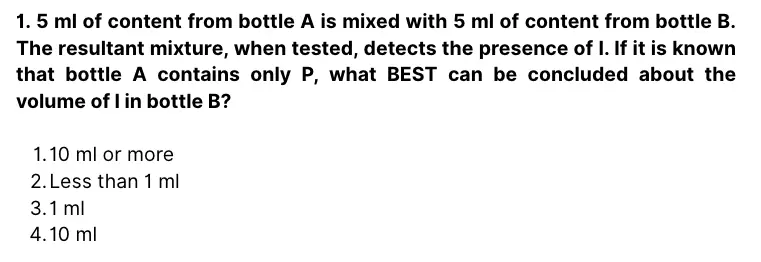
Given, A = 0% I and 100% P
Let B = x% I and (100 – x)% P
Since they are mixed in equal quantity to detect the presence of I.
(0% I + x% I)/2 ≥ 10% Total, x% I ≥ 20% Total
Hence, x% I ≥ 20% of 50 ml = 10 ml

Since each bottle contains only P or only I
Take equal quantity from each bottle say 10 ml and mix them
Now, if at least any one of them will contain only I, then
I % = 10/40 × 100 = 25% > 10%, so impurity will be detected
And if all four bottles contain only P, then 0% I will be detected
Hence, minimum of 1 test required to ascertain that all of them contain only P

Since three bottles contains only P and one contains 80% P and 20% I
Taking equal quantity from each bottle say 10 ml and mixing them
I % = 2/40 × 100 = 5% < 10%, so only one test is not sufficient to detect the bottle
Let the bottles be B1, B2, B3 and B4 in any order
Now consider any two bottles (say B1 and B2) and take equal quantity from each bottle say 10 ml and mix them,
Case I, if I% = 0, then both the bottles are only P and now take any one bottle from either B1 or B2 and mix with either B3 or B4
if I% is still = 0, then the remaining bottle contains 20% I
and if I% = (0 + 20)/2 = 10, then the newly mixed bottle contains 20% I
Case II, if I% = 10, then remaining B3 and B4 are only P, now take either B1 or B2 and mix with B3 or B4
If I% = 0, then the other bottle among B1 or B2 contains 20% I
And if I% is still = 10, then the bottle taken among B1 or B2 contains 20% I
Hence, minimum of 2 tests required in either of the cases
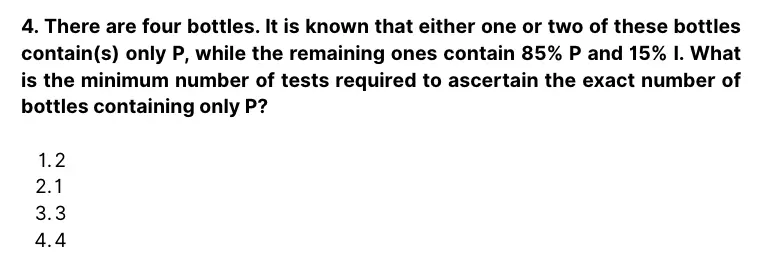
Case I, if only one bottle contains only P and remaining three bottles contains
15% I
Take equal quantity from each bottle and mix them
I% = (0 + 15 + 15 + 15)/4 = 11.25 > 10, so impurity will be detected
Case II, if two bottles contain only P and remaining two bottles contain 15% I
Take equal quantity from each bottle and mix them
I% = (0 + 0 + 15 + 15)/4 = 7.5 < 10, so impurity will not be detected
Hence, minimum of only 1 test ascertain the exact number of bottles containing only P
Day 10 of 100: VARC Paragraph Summary
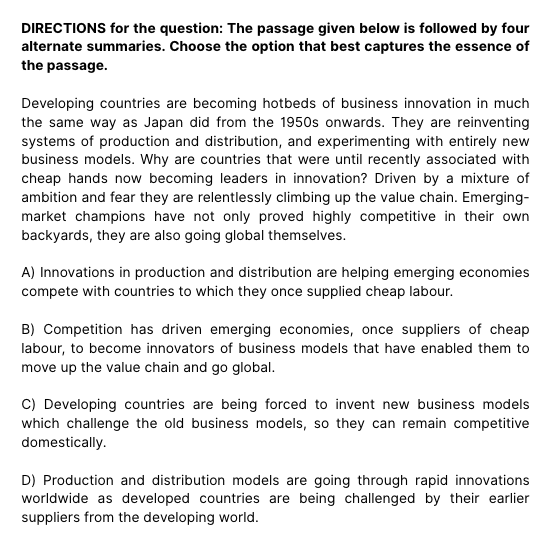
Correct Answer
Option B
Options A & D are wrong as they focus on production & distribution & miss on ‘business models’. Option C is wrong as the developing economies are not being forced into something.
Day 11 of 100: Tip of the Day
Day 12 of 100: DILR Set
In an event, eight races were organized. In each race, four runners from four different states – Bihar, UP, MP and WB – participate and only one of them emerged as winner. For each of the eight races, at least four of the five persons – P, Q, R, S and T – predicted state which would win that race. Following table gives the predictions made by person for the eight races.
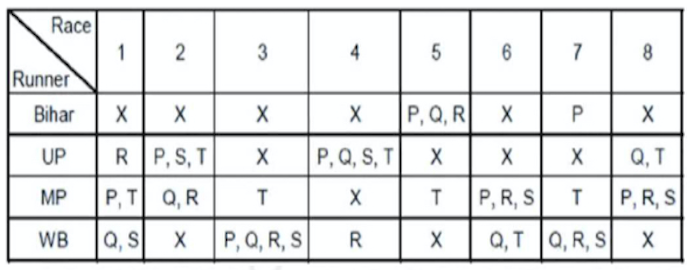
For example, ‘R’ predicted UP to win Race 1, whereas P and T predicted MP to win Race 1 and no one predicted Bihar to win Race 1.
It is also known that:
A person got Rs. 6000 for a correct prediction and lost Rs. 2000 for a wrong prediction.
At the end of the eight races, Q earned the maximum amount of Rs 32000. T neither gained nor lost any amount.
Had ‘R’ made one more correct prediction and Q made one more wrong prediction, the amounts gained by them at the end of the eight races would have got interchanged.
At the end of the eight races, it was observed that had any person predicted that a single state would win all the eight races, he would not have gained or lost any amount.
Q1. What was the amount gained by P at the end of 8 races?
Q2. How many correct predictions did S make?
Q3. How many wrong predictions did Q make?
Q4. In how many races was the winner not predicted correctly by any of the persons?
Correct Answer 1
16000
Correct Answer 2
3
Correct Answer 3
2
Correct Answer 4
1
Day 13 of 100: VARC - Odd One Out
Five jumbled up sentences (labelled 1, 2, 3, 4 and 5), related to a topic, are given below. Four of them can be put together to form a coherent paragraph. Identify the odd sentence and key in the number of that sentence as your answer.
- It is a ridiculously fun movie with enviable quality where, while watching it, it is constantly impossible to determine what happens next.
- I loved Megalopolis.
- Perhaps I am too close to my own grandfather to not find myself fascinated and moved by such a holistic realization of the male boomer worldview.
- Regardless, Megalopolis is a rousingly personal summation of a generation’s ethos by one of its Great Artists, with all the follies of judgment and artistic limitations one might expect.
- Perhaps I am being seduced by the allure of late-style auteurism.
Correct Answer
Option 1


Day 14 of 100: QA Geometry
A trapezium has its shorter and the longer sides as 4 cm and 20 cm respectively. Its parallel sides are 5 cm apart. Find its area (in sq cm).
- 40
- 50
- 60
- 70
Correct Answer
C. 60
Day 15 of 100: Tip of the Day
Many DILR sets are built on ambiguity, forcing you to use case-wise analysis. Learn to identify conditions that split the possibilities and create separate ‘cases’ or scenarios to test each. Do not guess or assume.
Day 16 of 100: VARC Vocabulary
Word: Obfuscate (verb)
Meaning: To deliberately make something unclear, difficult to understand, or obscure.
Example in a sentence: “The politician’s statement served only to obfuscate the core issue of the budget deficit, steering the conversation toward irrelevant procedural details.”
Synonyms: Confound, bewilder, muddle, cloud.
Why it’s important: This word is frequently used in passages discussing arguments, rhetoric, or politics, where an author might critique another’s lack of clarity or intention to mislead.
Day 17 of 100: QA Profit & Loss
A merchant purchases a cloth at a rate of Rs.100 per meter and receives 5 cm length of cloth free for every 100 cm length of cloth purchased by him. He sells the same cloth at a rate of Rs.110 per meter but cheats his customers by giving 95 cm length of cloth for every 100 cm length of cloth purchased by the customers. If the merchant provides a 5% discount, the resulting profit earned by him is
- 9.7%
- 42%
- 15.5%
- 16%
Correct Answer
C. 15.5%
Day 18 of 100: DILR Set
Ten persons named M, N, O, P, Q, R, S, T, U and V live one above another in a building which has 10 floors. The bottom-most floor is number one and the topmost floor is number 10. The age of each person is a different number of years among 2, 9, 10, 11, 29, 20, 15, 28, 35 and 50 years. The persons with odd numbered age live on even numbered floor and person with even numbered age live on odd numbered floor. E.g., person whose age is 2 years can live on floor number 1, 3, 5 and so on. T is three floors above the floor, where the person of 9 years old lives. The average age of S and M is equal to the age of P. There are two floors between U and Q. Age of U is 10 years. M lives on a floor above U, who lives above O. S does not live on the bottom-most floor and his age is more than the age of T. R lives just above V. T’s age is not 2 years. N, whose age is 29 years, lives on topmost floor. Age of Q is 15 years. There are three people who live above U.
Q1. Which person lives just above the person whose age is the lowest?
- U
- V
- R
- P
- U
- N
- T
- P
- 13
- 11
- 59
- 52
- 28
- 11
- 10
- 15
Correct Answer 1
C. RCorrect Answer 2
D. P
Correct Answer 3
B. 11
Correct Answer 4
A. 28Day 19 of 100: Reading Comprehension
The apparent change from the rather mechanistic explanation of evolution put forth by the Greeks to the more creationist reasoning found later in Europe was a significant paradigm shift, yet it is clear that the idea of evolution was not first pioneered by Darwin himself.
It is essential to confront the creationist issue and to look at it in a scientific manner. Creationism is not science and doesn’t belong in the science classroom. However, a frank discussion of creationism with students is also important. To avoid it may suggest that perhaps there is something valid there, lurking in the irrationality.
The late Carl Sagan, one of the staunchest advocates of rationality and reason in the increasingly irrational and superstitious world in which we live, has defended the importance of good science teaching by saying: “In the demon-haunted world that we inhabit by virtue of being human, [science] may be all that stands between us and the enveloping darkness.” In its most simple form, the concept of evolution is that populations of organisms change over time. One can trace the origins of evolutionary thought at least as far back as the Greeks.
Anaximander, in 500 BC, held the belief that living creatures were formed from water and that humans and other animals were descended from fishes. Empedocles, around 400 BC, proposed an evolutionary hypothesis in which he stated that heads, limbs, and various other parts of animals were continuously joined in random combinations – e.g. human heads with cows’ bodies – and that only some of these combinations were fit for survival.
Christian philosophers later elaborated on the ideas of Aristotle and Plato when they reasoned that because existence is a good thing and because God is considered benevolent, God must have bestowed existence on all creatures. This twist of circular reasoning, to which the name —natural theologyll was applied, dominated the period preceding Darwin, and this philosophy resisted change long after Darwin published his theory of natural selection in 1859.
Thomas Huxley, one of Darwin’s most ardent supporters, was one of the founding members of the powerful London School Board, which helped to set curriculum guidelines for students and teachers. However, in the United States a strong biblical fundamentalism was taking hold, using the Bible as both a means of consolation as well as a guide for moral conduct. Many states passed laws banning the teaching of evolution in schools, and teachers who persisted either did so quietly or allowed themselves to be martyred. Most recently, those opposed to the teaching of evolution in schools have pressed the idea of “creation science,” a tactic devised by creationists in the late 1960s to infiltrate America’s science classrooms with religious ideas.
Creation science, despite the apparent oxymoron, is a phrase that has been widely used by creationists to add legitimacy to their claims by stating that creationism is a scientific theory just as much as evolution. By claiming that their ideas are scientific, creationists could then demand equal time in the classroom devoted to both evolutionary theory and the “theory” of creationism.
Correct Answer 1
Option BCorrect Answer 2
Option C
Correct Answer 3
Option D
Q1. When reviewing all of the arguments made in the passage it becomes apparent that the author’s main idea in this passage is:
- to explain the differences between natural selection and creation science.
- to show how the continued spread of creationist views is a potentially dangerous affront to a rational, scientific understanding of evolution.
- to contrast the creationist viewpoints, such as fundamentalism and natural theology with more ancient views of evolution.
- to explain why the concepts of evolution are more scientifically correct than those of —creation science.
- to argue that creation science is the best explanation of evolution
Correct Answer 1
Option B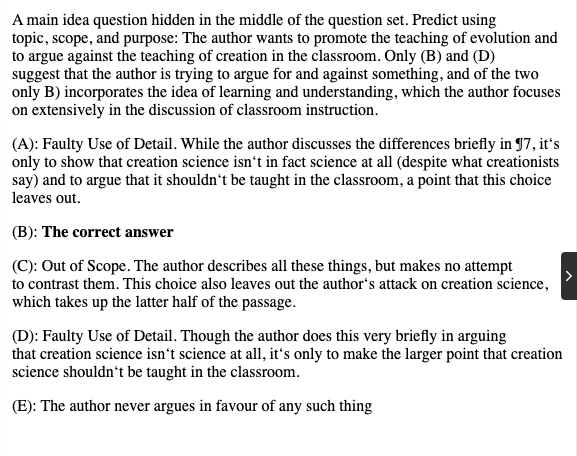
Q2. The author brings up Greek philosophers to point out which of the following:
- that the origins of evolutionary thought comprised some silly notions such as heads, limbs, and various other parts of animals were always being joined in random combinations.
- that the origins of evolutionary thought began long before Darwin.
- that both evolutionary thought and creationism have their origins among the Greeks.
- Anaximander first came up with the theory of evolution.
- Greeks were far more learned than any other group at that time
Correct Answer 2
Option C
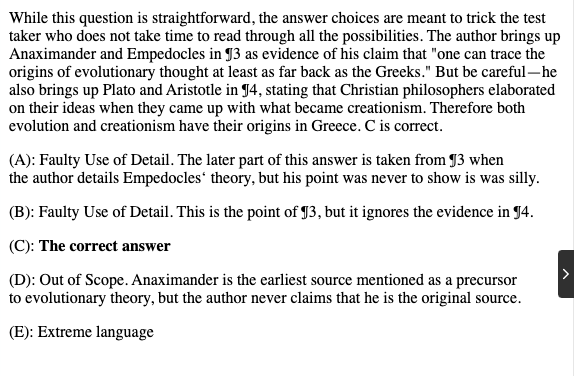
Q3. Which of the following can be inferred from the passage?
- A frank discussion of creationism is pointless
- Carl Sagan was indifferent towards rationality
- Anaximander believed that humans were descended from apes
- Thomas Huxley approved of Darwin’s theories
- Christian philosophers rejected the ideas of Aristotle and Plato
Correct Answer 3
Option D
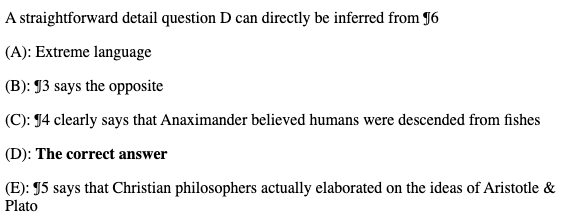
Day 20 of 100: QA Shortcuts - Functions
If
f(x+y) = f(x) + f(y), then f(x) = kx, k∈R
f(xy) = f(x)f(y), then f(x) = x^m, m∈R
f(x+y) = f(x).f(y), then f(x) = a^x, a∈R
f(xy) = f(x)+f(y), then f(x) = log x
f(x) + f(1/x) = f(x).f(1/x), then f(x) = x^n±1,
where ‘n’ is a natural number
Day 21 of 100: DILR Set
The function ‘Difference (N)’ takes a non negative integer N as a parameter and returns the absolute difference of N and the number obtained by reversing the digits of N. For a two digit natural number X with distinct digits, a set of six non negative integers {P, Q, R, S, T, U} is defined such that P = Difference(X), Q = Difference(P), R = Difference(Q), S = Difference(R), T = difference(S) and U = Difference(T)
Q1. If the value of I is not equal to zero, then what is the largest possible value for X?
- 86
- 90
- 68
- None of these
Q2. If d is the difference between the two digits of X and d = 4, then what is the sum of P, Q, R, S, T and U?
- 128
- 117
- 136
- 158
Q4. If X is greater than 50, then what is the maximum possible value of U?
Correct Answer 1
D. None of theseCorrect Answer 2
B. 117
Correct Answer 3
9
Correct Answer 4
0
Day 22 of 100: VARC Paragraph Completion
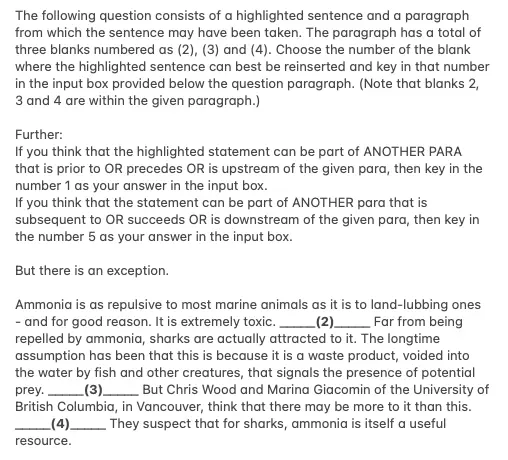
Correct Answer
2

Day 23 of 100: Tip of the Day
“Success is the sum of small efforts, repeated day in and day out.”
Remember that the magic of your 100-day prep lies not in a single breakthrough, but in the compounding effect of your daily efforts. Every single effort, no matter how small, brings you one step closer to your goal.
Day 24 of 100: Quant Question of the Day
[x] denotes the least integer greater than or equal to x. Find the index of highest power of 2 which [1012/(105 + 5)]
Correct Answer
0
Day 25 of 100: DILR Set
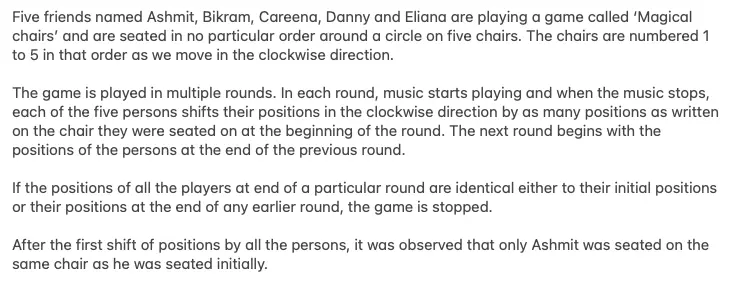
Q1. In how many different ways the persons can be seated on the chairs initially?
Q2. Initially, Eliana is the only person seated between Danny and Careena and she is not seated on chairs 1 or 4. Similarly, initially Danny is the only person seated between Ashmit and Eliana. What is the number of the chair occupied by Bikram?
Q3. How many rounds did the game have before it was stopped?
Q4. If it is known that initially before the game began, Bikram was the immediate neighbour of Ashmit and at the end of round 2, Bikram was not in chair 4, how many persons will be seated between Ashmit and Bikram at the end of the third round in the clockwise direction starting with Ashmit? (Write 5 if your answer is ‘Cannot be determined’)
Correct Answer 1
24
Correct Answer 2
Cannot be determinedCorrect Answer 3
4Correct Answer 4
1
Day 26 of 100: VARC - Para-jumble
DIRECTIONS for the question: The four sentences (labelled 1,2,3 and 4) given in this question, when properly sequenced, form a coherent paragraph. Decide on the proper order for the sentence and key in this sequence of four numbers as your answer.
- Conceptualisations of ‘women’s time’ as contrary to clock-time and clock-time as synonymous with economic rationalism are two of the deleterious results of this representation.
- While dichotomies of ‘men’s time’, ‘women’s time’, clock-time, and caring time can be analytically useful, this article argues that everyday caring practices incorporate a multiplicity of times; and both men and women can engage in these multiple-times
- When the everyday practices of working sole fathers and working sole mothers are carefully examined to explore conceptualisations of gendered time, it is found that caring time is often more focused on the clock than generally theorised.
- Clock-time has been consistently represented in feminist literature as a masculine artefact representative of a ‘time is money’ perspective
Correct Answer
4132The opener in this case will be 4 as it introduces the idea of representation of 'clock - time ' with respect to 'time is money' perspective'. After this 1 as there is clear link 'this representation'. 3 is explaining that actually caring time is often more focussed on clock though clock time has been seen as a masculine artefact. Hence 3 questions stts concept of clock time as masculine artefact. 2 concludes and answers the question being raised in 3
Day 27 of 100: Quant - Average
A CAT aspirant appears for a certain number of tests. His average score increases by 1 if the first 10 tests are not considered, and decreases by 1 if the last 10 tests are not considered. If his average scores for the first 10 and the last 10 tests are 20 and 30, respectively, then the total number of tests taken by him is
Correct Answer
60
Day 28 of 100: DILR Set
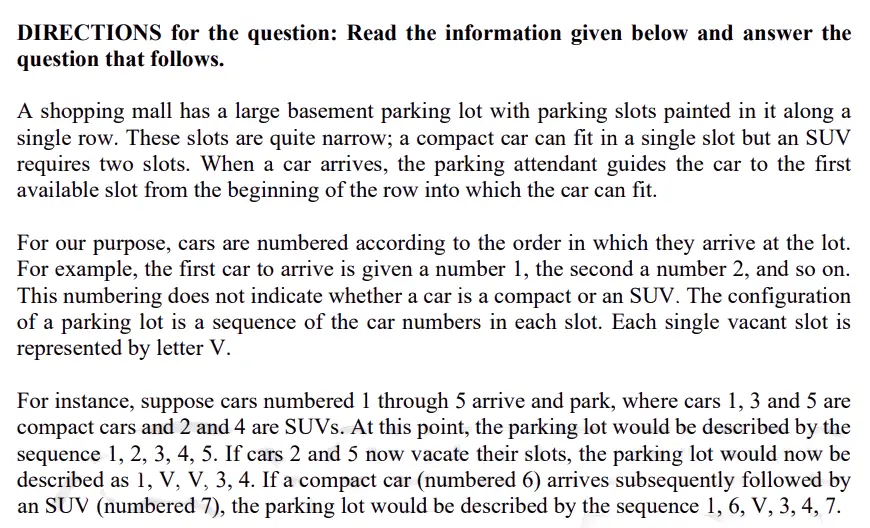
Correct Answer 1
Option C
Correct Answer 2
Option A
Correct Answer 3
Option A
Correct Answer 4
Option C
Q1. Initially cars numbered 1, 2, 3, and 4 arrive among which 1 and 4 are SUVs while 2 and3 are compact cars. Car 1 then leaves, followed by the arrivals of car 5 (a compact car) and car 6 (an SUV). Car 4 then leaves. Then car 7 (an SUV) and car 8 (a compact car)arrive. At this moment, which among the following numbered car is parked next to car 3?
- 8
- 5
- 7
- 8
The initial cars are 1, 2, 3, 4, when can 1 leaves, we have the arrangement V V 2 3 4 Now car 5 (a compact car) and car 6 (an SUV) came. So arrangement is 5 V 2 3 4 6 Now care 4 left, we have the arrangement 5 V 2 3 V V 6 Now car 7 (an S U V) and car 8 ( a compact car) arrived, so final arrangement is 5, 8, 2, 3, 7, 6. Hence car number 7 is parked next to car 3.
- 8, 2, 3, V, 5, 6, 7
- 8, 2, 3, V, 6, 5, 7
- V, 2, 3, 7, 5, 6, 8
- 8, 2, 3, V, 5, 7, 6
As per the options, car 1 & car 4 left as Car 8 is the last car to arrive, so it should be either at 1st position or the last position. So option 3 is wrong. In option 2, the position of car 4 is vacant. If car 5 arrived after car 4 left, then it should have been next to car 3. If car 4 left after the car 5 arrived, then car 5 should be next to V. in any case, car 5 cannot be after car 6. Hence option 2 is wrong. In option 4, it is clear that car 4 left after car 5 arrived. So car next to car 5 should be car 6. Hence it is wrong. Only option 1 is true where car 4 left after car 5 arrived.
- Car 3 is an SUV
- Car 5 is a compact
- Car 4 is a compact
- Car 1 is an SUV
Total cars arrived here are 6 and car 3 is placed in the end. It is possible it cars 1 & 2 are S UV, then we have the arrangement 1 2 3 Now cars 1 & 2 left, then the arrangement is V V V V 3 After that the cars 4, 5, 6 arrived in order so that the final arrangement is. 4 5 6 V 3 Hence cars 4 & 5 are compact & car 1 is an S U V. but we cannot say about car 3, whether it is an S U V or a compact car.
- Car 4 is an SUV
- Car 2 is a compact
- Car 6 is a compact
- Car 7 is a compact
The original order is 1 2 3 4 5. Now car 6 is at the place of car 4 and car 4 is not the first one to leave. So either car 1 & car 2 will leave first. If we assume that the first car left is car 1, them as car 2 is also leaving, so car 7 will take the first position. So first position cannot be empty. Hence car 2 is the one which left at the first place and after it car 4 left. So we have following possibilities. 1 V 3 V 5 or 1 V 3 V V 5 Car 2 is not an S U V because in that case, car 6 will be next to car 1. Also car 6 is not compact otherwise, it will be again next to car 1. So car 6 is an S U V and we have the order 1 V 3 6 5 Now car 7 came which is compact and order is 1 7 3 6 5. After that the car 1 left to give the final order as V 7 3 6 5
Day 29 of 100: VARC Vocabulary
Word: Exacerbate (verb)
Meaning: To make a problem, bad situation, or negative feeling worse.
Example in a Sentence: “The new regulations, rather than fixing the housing crisis, only served to exacerbate the issue by driving up property prices in the urban centers.”
Synonyms: Aggravate, worsen, intensify, inflame.
Why it’s important: A very common word in passages related to social, political, or economic issues. It’s a key term for identifying cause-and-effect relationships and understanding an author’s argument.
Day 30 of 100: Quant - Average
The equation ax²+bx+c = 0 and 5x²+12x+13 = 0 have a common root where a,b,c are the side lengths of triangles ABC then find Angle C
Correct Answer
90°

